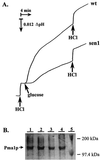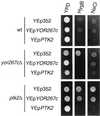Regulation of yeast H(+)-ATPase by protein kinases belonging to a family dedicated to activation of plasma membrane transporters
- PMID: 11003661
- PMCID: PMC86331
- DOI: 10.1128/MCB.20.20.7654-7661.2000
Regulation of yeast H(+)-ATPase by protein kinases belonging to a family dedicated to activation of plasma membrane transporters
Abstract
The regulation of electrical membrane potential is a fundamental property of living cells. This biophysical parameter determines nutrient uptake, intracellular potassium and turgor, uptake of toxic cations, and stress responses. In fungi and plants, an important determinant of membrane potential is the electrogenic proton-pumping ATPase, but the systems that modulate its activity remain largely unknown. We have characterized two genes from Saccharomyces cerevisiae, PTK2 and HRK1 (YOR267c), that encode protein kinases implicated in activation of the yeast plasma membrane H(+)-ATPase (Pma1) in response to glucose metabolism. These kinases mediate, directly or indirectly, an increase in affinity of Pma1 for ATP, which probably involves Ser-899 phosphorylation. Ptk2 has the strongest effect on Pma1, and ptk2 mutants exhibit a pleiotropic phenotype of tolerance to toxic cations, including sodium, lithium, manganese, tetramethylammonium, hygromycin B, and norspermidine. A plausible interpretation is that ptk2 mutants have a decreased membrane potential and that diverse cation transporters are voltage dependent. Accordingly, ptk2 mutants exhibited reduced uptake of lithium and methylammonium. Ptk2 and Hrk1 belong to a subgroup of yeast protein kinases dedicated to the regulation of plasma membrane transporters, which include Npr1 (regulator of Gap1 and Tat2 amino acid transporters) and Hal4 and Hal5 (regulators of Trk1 and Trk2 potassium transporters).
Figures







References
-
- Auer M, Scarborough G A, Kühlbrandt W. Three-dimensional map of the plasma membrane H+-ATPase in the open conformation. Nature. 1998;392:840–843. - PubMed
-
- Balcells L, Martin R, Ruiz M C, Gomez N, Ramos J, Ariño J. The Pzh1 protein phosphatase and the Spm1 protein kinase are involved in the regulation of the plasma membrane H+-ATPase in fission yeast. FEBS Lett. 1998;435:241–244. - PubMed
-
- Boeke J D, Sandmeyer S B. Yeast transposable elements. In: Broach J R, Jones E W, Pringle J R, editors. The molecular and cellular biology of the yeast Saccharomyces: genome dynamics, protein synthesis and energetics. Cold Spring Harbor, N.Y: Cold Spring Harbor Laboratory Press; 1991. pp. 193–261.
-
- Braley R, Piper P W. The C-terminus of yeast plasma membrane H+-ATPase is essential for the regulation of this enzyme by heat shock protein Hsp30, but not for stress activation. FEBS Lett. 1997;418:123–126. - PubMed
Publication types
MeSH terms
Substances
LinkOut - more resources
Full Text Sources
Other Literature Sources
Molecular Biology Databases
Miscellaneous
